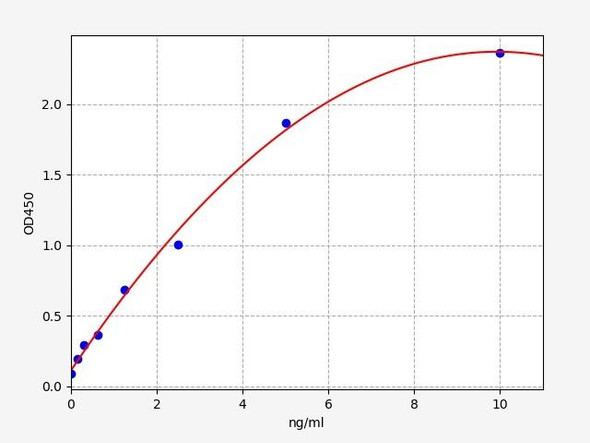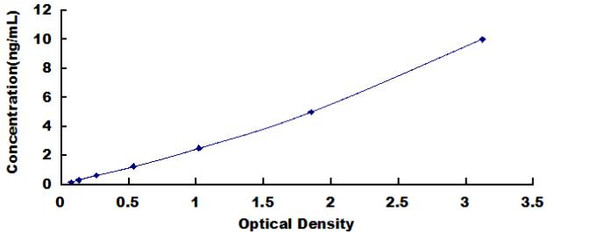Description
Human Trans-acting T-cell-specific transcription factor GATA-3 (GATA3) ELISA Kit
The Human GATA3 ELISA Kit is specially designed for the precise measurement of GATA3 levels in human samples, including serum, plasma, and cell culture supernatants. With its high sensitivity and specificity, this kit delivers accurate and consistent results, making it a valuable tool for various research applications.GATA3 is a trans-acting T cell-specific transcription factor that plays a crucial role in the regulation of gene expression and immune response. It is key in T cell differentiation, maturation, and function, making it a significant biomarker in immune-related diseases and disorders.
By using the Human GATA3 ELISA Kit, researchers can gain insights into the role of GATA3 in various physiological and pathological processes, including autoimmune diseases, allergies, and immune-mediated disorders. This kit enables precise quantification of GATA3 levels, facilitating in-depth investigations and potential therapeutic developments related to GATA3.
| Product Name: | Human Trans-acting T-cell-specific transcription factor GATA-3 (GATA3) ELISA Kit |
| SKU: | HUEB0643 |
| Size: | 96T |
| Target: | Human Trans-acting T-cell-specific transcription factor GATA-3 (GATA3) |
| Synonyms: | GATA-binding factor 3 |
| Assay Type: | Sandwich |
| Detection Method: | ELISA |
| Reactivity: | Human |
| Detection Range: | 0.312-20ng/mL |
| Sensitivity: | 0.182ng/mL |
| Intra CV: | 3.2% | ||||||||||||||||||||
| Inter CV: | 6.1% | ||||||||||||||||||||
| Linearity: |
| ||||||||||||||||||||
| Recovery: |
| ||||||||||||||||||||
| Function: | Transcriptional activator which binds to the enhancer of the T-cell receptor alpha and delta genes. Binds to the consensus sequence 5'-AGATAG-3'. Required for the T-helper 2 (Th2) differentiation process following immune and inflammatory responses. |
| Uniprot: | P23771 |
| Sample Type: | Serum, plasma, tissue homogenates, cell culture supernates and other biological fluids |
| Specificity: | Natural and recombinant human Trans-acting T-cell-specific transcription factor GATA-3 |
| Subcellular Location: | Nucleus |
| Storage: | Please see kit components below for exact storage details |
| Note: | For research use only |
| UniProt Protein Function: | GATA3: a transcriptional regulator central in Th2 cell differentiation. Inhibits breast cancer growth and pulmonary breast cancer metastasis. Represses INK4C transcription, constrains luminal progenitor cell expansion, and suppresses luminal tumorigenesis in the mammary gland. High GATA3 and low INK4C expression predicts a favorable patient outcome in luminal A type breast tumors. IFN-lambda1 (IL-29) inhibits GATA3 expression and suppresses Th2 responses in human T cells. GATA3 haploinsufficiency leads to HDR (hypoparathyroidism, deafness, and renal dysplasia) syndrome. Two alternatively spliced human isoforms have been described. |
| UniProt Protein Details: | Protein type:Transcription factor Chromosomal Location of Human Ortholog: 10p15 Cellular Component: nucleoplasm; nuclear chromatin; nucleolus; nucleus Molecular Function:protein dimerization activity; protein binding; DNA binding; zinc ion binding; interleukin-2 receptor binding; transcription coactivator activity; transcription factor binding; transcription factor activity Biological Process: developmental growth; positive regulation of transcription, DNA-dependent; cell maturation; ear development; cell fate determination; uterus development; T cell receptor signaling pathway; post-embryonic development; negative regulation of interleukin-2 production; norepinephrine biosynthetic process; regulation of neuron apoptosis; erythrocyte differentiation; anatomical structure formation; mesonephros development; kidney development; regulation of cytokine biosynthetic process; response to drug; thymic T cell selection; anatomical structure morphogenesis; inner ear morphogenesis; positive regulation of signal transduction; embryonic hemopoiesis; response to virus; negative regulation of fat cell differentiation; parathyroid gland development; negative regulation of mammary gland epithelial cell proliferation; response to ethanol; positive regulation of T cell differentiation; response to estrogen stimulus; positive regulation of transcription from RNA polymerase II promoter; pro-T cell differentiation; negative regulation of transcription, DNA-dependent; regulation of CD4-positive, alpha beta T cell differentiation; transcription from RNA polymerase II promoter; lens development in camera-type eye; axon guidance; phosphoinositide 3-kinase cascade; TOR signaling pathway; neuron migration; defense response; negative regulation of transcription from RNA polymerase II promoter; signal transduction; negative regulation of cell cycle; positive regulation of interleukin-4 production; negative regulation of cell proliferation; sympathetic nervous system development; negative regulation of interferon-gamma production; response to gamma radiation; type IV hypersensitivity; pharyngeal system development; thymus development; in utero embryonic development; male gonad development; humoral immune response; positive regulation of protein kinase B signaling cascade; negative regulation of inflammatory response; innate immune response; regulation of histone H3-K4 methylation; T-helper 2 cell differentiation; blood coagulation Disease: Hypoparathyroidism, Sensorineural Deafness, And Renal Disease |
| NCBI Summary: | This gene encodes a protein which belongs to the GATA family of transcription factors. The protein contains two GATA-type zinc fingers and is an important regulator of T-cell development and plays an important role in endothelial cell biology. Defects in this gene are the cause of hypoparathyroidism with sensorineural deafness and renal dysplasia. [provided by RefSeq, Nov 2009] |
| UniProt Code: | P23771 |
| NCBI GenInfo Identifier: | 120962 |
| NCBI Gene ID: | 2625 |
| NCBI Accession: | P23771.1 |
| UniProt Secondary Accession: | P23771,Q5VWG7, Q5VWG8, Q96J16, |
| UniProt Related Accession: | P23771 |
| Molecular Weight: | 443 |
| NCBI Full Name: | Trans-acting T-cell-specific transcription factor GATA-3 |
| NCBI Synonym Full Names: | GATA binding protein 3 |
| NCBI Official Symbol: | GATA3 |
| NCBI Official Synonym Symbols: | HDR; HDRS |
| NCBI Protein Information: | trans-acting T-cell-specific transcription factor GATA-3; GATA-binding factor 3 |
| UniProt Protein Name: | Trans-acting T-cell-specific transcription factor GATA-3 |
| UniProt Synonym Protein Names: | GATA-binding factor 3 |
| Protein Family: | GATA-binding factor |
| UniProt Gene Name: | GATA3 |
| UniProt Entry Name: | GATA3_HUMAN |
| Component | Quantity (96 Assays) | Storage |
| ELISA Microplate (Dismountable) | 8×12 strips | -20°C |
| Lyophilized Standard | 2 | -20°C |
| Sample Diluent | 20ml | -20°C |
| Assay Diluent A | 10mL | -20°C |
| Assay Diluent B | 10mL | -20°C |
| Detection Reagent A | 120µL | -20°C |
| Detection Reagent B | 120µL | -20°C |
| Wash Buffer | 30mL | 4°C |
| Substrate | 10mL | 4°C |
| Stop Solution | 10mL | 4°C |
| Plate Sealer | 5 | - |
Other materials and equipment required:
- Microplate reader with 450 nm wavelength filter
- Multichannel Pipette, Pipette, microcentrifuge tubes and disposable pipette tips
- Incubator
- Deionized or distilled water
- Absorbent paper
- Buffer resevoir
*Note: The below protocol is a sample protocol. Protocols are specific to each batch/lot. For the correct instructions please follow the protocol included in your kit.
Allow all reagents to reach room temperature (Please do not dissolve the reagents at 37°C directly). All the reagents should be mixed thoroughly by gently swirling before pipetting. Avoid foaming. Keep appropriate numbers of strips for 1 experiment and remove extra strips from microtiter plate. Removed strips should be resealed and stored at -20°C until the kits expiry date. Prepare all reagents, working standards and samples as directed in the previous sections. Please predict the concentration before assaying. If values for these are not within the range of the standard curve, users must determine the optimal sample dilutions for their experiments. We recommend running all samples in duplicate.
| Step | |
| 1. | Add Sample: Add 100µL of Standard, Blank, or Sample per well. The blank well is added with Sample diluent. Solutions are added to the bottom of micro ELISA plate well, avoid inside wall touching and foaming as possible. Mix it gently. Cover the plate with sealer we provided. Incubate for 120 minutes at 37°C. |
| 2. | Remove the liquid from each well, don't wash. Add 100µL of Detection Reagent A working solution to each well. Cover with the Plate sealer. Gently tap the plate to ensure thorough mixing. Incubate for 1 hour at 37°C. Note: if Detection Reagent A appears cloudy warm to room temperature until solution is uniform. |
| 3. | Aspirate each well and wash, repeating the process three times. Wash by filling each well with Wash Buffer (approximately 400µL) (a squirt bottle, multi-channel pipette,manifold dispenser or automated washer are needed). Complete removal of liquid at each step is essential. After the last wash, completely remove remaining Wash Buffer by aspirating or decanting. Invert the plate and pat it against thick clean absorbent paper. |
| 4. | Add 100µL of Detection Reagent B working solution to each well. Cover with the Plate sealer. Incubate for 60 minutes at 37°C. |
| 5. | Repeat the wash process for five times as conducted in step 3. |
| 6. | Add 90µL of Substrate Solution to each well. Cover with a new Plate sealer and incubate for 10-20 minutes at 37°C. Protect the plate from light. The reaction time can be shortened or extended according to the actual color change, but this should not exceed more than 30 minutes. When apparent gradient appears in standard wells, user should terminatethe reaction. |
| 7. | Add 50µL of Stop Solution to each well. If color change does not appear uniform, gently tap the plate to ensure thorough mixing. |
| 8. | Determine the optical density (OD value) of each well at once, using a micro-plate reader set to 450 nm. User should open the micro-plate reader in advance, preheat the instrument, and set the testing parameters. |
| 9. | After experiment, store all reagents according to the specified storage temperature respectively until their expiry. |
When carrying out an ELISA assay it is important to prepare your samples in order to achieve the best possible results. Below we have a list of procedures for the preparation of samples for different sample types.
| Sample Type | Protocol |
| Serum | If using serum separator tubes, allow samples to clot for 30 minutes at room temperature. Centrifuge for 10 minutes at 1,000x g. Collect the serum fraction and assay promptly or aliquot and store the samples at -80°C. Avoid multiple freeze-thaw cycles. If serum separator tubes are not being used, allow samples to clot overnight at 2-8°C. Centrifuge for 10 minutes at 1,000x g. Remove serum and assay promptly or aliquot and store the samples at -80°C. Avoid multiple freeze-thaw cycles. |
| Plasma | Collect plasma using EDTA or heparin as an anticoagulant. Centrifuge samples at 4°C for 15 mins at 1000 × g within 30 mins of collection. Collect the plasma fraction and assay promptly or aliquot and store the samples at -80°C. Avoid multiple freeze-thaw cycles. Note: Over haemolysed samples are not suitable for use with this kit. |
| Urine & Cerebrospinal Fluid | Collect the urine (mid-stream) in a sterile container, centrifuge for 20 mins at 2000-3000 rpm. Remove supernatant and assay immediately. If any precipitation is detected, repeat the centrifugation step. A similar protocol can be used for cerebrospinal fluid. |
| Cell culture supernatant | Collect the cell culture media by pipette, followed by centrifugation at 4°C for 20 mins at 1500 rpm. Collect the clear supernatant and assay immediately. |
| Cell lysates | Solubilize cells in lysis buffer and allow to sit on ice for 30 minutes. Centrifuge tubes at 14,000 x g for 5 minutes to remove insoluble material. Aliquot the supernatant into a new tube and discard the remaining whole cell extract. Quantify total protein concentration using a total protein assay. Assay immediately or aliquot and store at ≤ -20 °C. |
| Tissue homogenates | The preparation of tissue homogenates will vary depending upon tissue type. Rinse tissue with 1X PBS to remove excess blood & homogenize in 20ml of 1X PBS (including protease inhibitors) and store overnight at ≤ -20°C. Two freeze-thaw cycles are required to break the cell membranes. To further disrupt the cell membranes you can sonicate the samples. Centrifuge homogenates for 5 mins at 5000xg. Remove the supernatant and assay immediately or aliquot and store at -20°C or -80°C. |
| Tissue lysates | Rinse tissue with PBS, cut into 1-2 mm pieces, and homogenize with a tissue homogenizer in PBS. Add an equal volume of RIPA buffer containing protease inhibitors and lyse tissues at room temperature for 30 minutes with gentle agitation. Centrifuge to remove debris. Quantify total protein concentration using a total protein assay. Assay immediately or aliquot and store at ≤ -20 °C. |
| Breast Milk | Collect milk samples and centrifuge at 10,000 x g for 60 min at 4°C. Aliquot the supernatant and assay. For long term use, store samples at -80°C. Minimize freeze/thaw cycles. |









